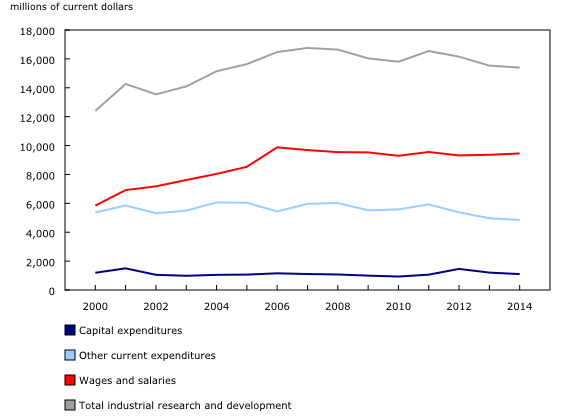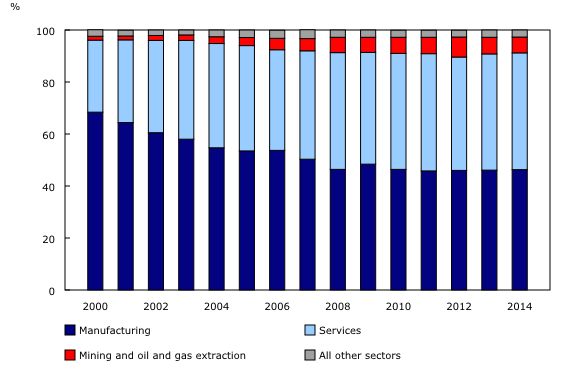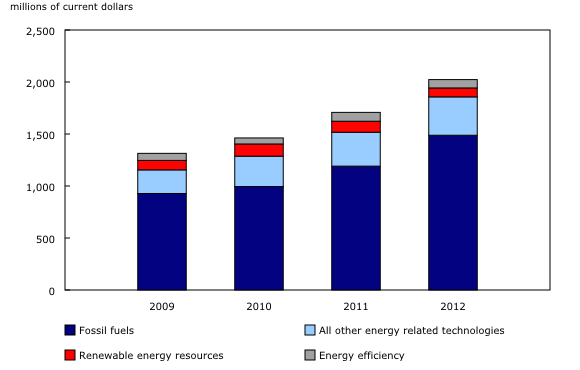Industrial research and development characteristics, 2014 (intentions)
Archived Content
Information identified as archived is provided for reference, research or recordkeeping purposes. It is not subject to the Government of Canada Web Standards and has not been altered or updated since it was archived. Please "contact us" to request a format other than those available.
Released: 2014-08-19
Spending intentions on industrial research and development, 2014
Industrial research and development spending will slow in 2014
Business enterprises in Canada anticipate spending $15.4 billion to perform research and development (R&D) activities in 2014, down 0.9% from 2013 intentions. Recovery from the 2008 economic downturn continues to be slow and business enterprises did not anticipate increasing R&D spending levels for 2014.
Industrial R&D spending is composed of two main categories, current and capital R&D spending. In 2014, current R&D spending is expected to total $14.3 billion, representing 93% of total industrial R&D spending. Wages and salaries will account for $9.5 billion. The remaining $4.8 billion will be directed to other current costs, such as the purchase of non-capital materials, contracts for on-site consultants and products required to support R&D activities.
Spending on capital R&D, such as machinery, equipment, land and buildings, is anticipated to be $1.1 billion in 2014 and to account for 7% of total industrial R&D spending. This proportion has hovered around 7% since 2002, after decreasing from 11% in 2001.
Industrial R&D spending is highly concentrated among businesses in Canada, with 100 business enterprises expected to perform one-half of total R&D spending in 2014.
Similarly, six industry groups will account for over half (54%) of industrial R&D spending in 2014, with two of the six industries in the manufacturing sector and four in the services industries. These six key industry groups have been leading industrial R&D performance since 2008.
Aerospace products and parts manufacturing ($1.4 billion) and communications equipment manufacturing ($1.3 billion) will lead manufacturing R&D spending. The sector's overall total is expected to reach $7.1 billion in 2014, down 0.4% from 2013. As a result, the share of total industrial R&D spending by manufacturers will continue the downward trend it started in 2001.
In services industries, scientific research and development services ($1.9 billion); computer systems design and related services ($1.3 billion); wholesale trade ($1.2 billion); and information and cultural industries ($1.2 billion) will lead R&D spending. R&D spending in services industries is expected to reach $6.9 billion in 2014, down 0.5% from 2013. The share of R&D spending by service industries has generally been expanding since 2001.
Characteristics of industrial research and development spending, 2012
Industrial R&D spending concentrated in Ontario and Quebec
Nationally, industrial R&D spending was $16.2 billion in 2012. Industrial R&D spending in Ontario decreased 4.0% from 2011 to $7.3 billion. Quebec spending declined 3.6% from the previous year to $4.6 billion. Together, the two provinces continued to account for about three-quarters of industrial R&D spending performed in 2012. Ontario experienced declines in R&D spending across most sectors. The decline in Quebec occurred mainly in services.
Industrial R&D rose 7.8% to $2.0 billion in Alberta in 2012. The increase was entirely attributable to the mining, oil and gas extraction industry, where R&D spending rose by $234 million.
British Columbia experienced lower industrial R&D spending in 2012, down 4.4% from the previous year to $1.6 billion. Spending on R&D in the services declined, offsetting a moderate rise in the province's manufacturing sector.
In Manitoba, industrial R&D spending increased 9.7% in 2012 to $215 million, mainly as a result of higher spending in the manufacturing sector. Meanwhile, R&D spending in Saskatchewan fell 2.6% from 2011 to $188 million in 2012, as current R&D spending, including spending on wages, salaries and R&D support, edged down.
Newfoundland and Labrador ($95 million) and Nova Scotia ($81 million) continued to spend the most on R&D among the Atlantic provinces. Industrial R&D spending in New Brunswick declined 29.6% to $69 million between 2011 and 2012, mostly as a result of declines in R&D spending in services industries. Spending on industrial R&D in Prince Edward Island was up, reaching $24 million in 2012.
Industrial R&D spending mainly focused on engineering and technology
R&D spending in engineering and technology totalled $12.7 billion in 2012, accounting for 79% of all industrial R&D performed in 2012. Natural and formal sciences, and medical and health sciences followed, each representing 10% of total spending. Agricultural sciences accounted for the remaining 2%.
Within engineering and technology, three fields of science or technology represented more than half (52%) of industrial R&D spending: electrical engineering, electronic engineering and information technology ($3.6 billion); software engineering ($2.6 billion); and mechanical engineering ($2.3 billion).
R&D spending in medical and health sciences reached $1.6 billion in 2012, with four industries accounting for 91% of such R&D spending: scientific research and development services ($522 million), wholesale trade ($493 million), pharmaceuticals and medicine manufacturing ($360 million) and health care and social assistance ($66 million).
In 2012, natural and formal sciences industrial R&D spending totalled $1.5 billion. Within this major field of science, R&D spending was led by computer and information sciences ($673 million), earth and related environmental sciences ($280 million) and chemical sciences ($269 million).
In 2012, $745 million was spent on environmental engineering and $280 million on earth and related environmental sciences. The mining, oil and gas extraction sector performed 77% ($577 million) of spending in environmental engineering R&D, as well as 64% ($178 million) of spending in R&D in earth and related environmental sciences.
Energy-related R&D grew rapidly
Energy-related R&D rose 18.4% from 2011 to $2.0 billion in 2012, mostly as a result of increases in R&D expenses related to fossil fuel technologies. R&D spending on fossil fuel technologies was concentrated in oil sands and heavy crude oil technologies, up 53.6% to $886 million, and in crude oil and natural gas technologies, almost unchanged at $554 million.
In contrast, R&D spending for energy efficiency technologies fell 5.9% to $80 million and spending for renewable energy resources technologies fell 18.9% to $86 million between 2011 and 2012.
Industrial R&D funded predominantly by performing firms
Businesses in Canada continued to finance most of their R&D activities through business operations, with internal corporate funds covering $13.8 billion (or 85%) of all industrial R&D spending in 2012. Funds from foreign sources followed at $1.7 billion.
Funds from government sources increased 6.4% from 2011 to $644 million in 2012, as an increase in provincial funding more than offset a decline in federal funding.
Industrial R&D personnel declined
The number of industrial R&D personnel continued to decline, falling 9.2% from 2011 to 132,156 full-time equivalents in 2012.
Note to readers
These data are subject to revision.
Data for 2012 on employment in research and development (R&D) activities, sources of funds for R&D, industrial R&D spending by province, extramural R&D payments and technology payments and receipts are now available.
Spending intentions for 2013 and 2014 are indications of the direction of R&D investments. Revised R&D expenditures for 2010 to 2013 are now available.
Also available are 2012 data from the Energy Research and Development Expenditures by Area of Technology survey.
Table CANSIM table358-0024: Industrial research and development (R&D) expenditures and personnel, Canada.
Table CANSIM table358-0161: Industrial R&D expenditures and personnel, provinces and territories.
Table CANSIM table358-0140: Industrial R&D expenditures and personnel, by field of science or technology.
Table CANSIM table358-0206: Business enterprise extramural payments for R&D, by location of recipient.
Tables CANSIM table358-0205, CANSIM table358-0207 to 358-0211: Business enterprise intramural R&D expenditures, selected characteristics.
Table CANSIM table358-0212: Business enterprise expenditures and payments for intellectual property and other technology assistance.
Table CANSIM table358-0213: Business enterprise foreign receipts and payments for technological services.
Table CANSIM table358-0214: Industrial energy R&D expenditures.
Definitions, data sources and methods: survey numbers survey number4201 and survey number4205.
The publication Industrial Research and Development: Intentions, 2014 (Catalogue number88-202-X), is now available from the Browse by key resource module of our website under Publications.
Contact information
For more information, contact us (toll-free 1-800-263-1136; 514-283-8300; infostats@statcan.gc.ca).
To enquire about the concepts, methods or data quality of this release, contact Charlene Lonmo (613-951-6617; charlene.lonmo@statcan.gc.ca) or Louise Earl (613-951-2880; louise.earl@statcan.gc.ca), Investment, Science and Technology Division.
- Date modified:




